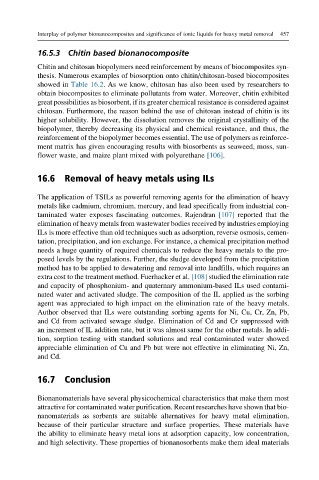Page 504 - Polymer-based Nanocomposites for Energy and Environmental Applications
P. 504
Interplay of polymer bionanocomposites and significance of ionic liquids for heavy metal removal 457
16.5.3 Chitin based bionanocomposite
Chitin and chitosan biopolymers need reinforcement by means of biocomposites syn-
thesis. Numerous examples of biosorption onto chitin/chitosan-based biocomposites
showed in Table 16.2. As we know, chitosan has also been used by researchers to
obtain biocomposites to eliminate pollutants from water. Moreover, chitin exhibited
great possibilities as biosorbent, if its greater chemical resistance is considered against
chitosan. Furthermore, the reason behind the use of chitosan instead of chitin is its
higher solubility. However, the dissolution removes the original crystallinity of the
biopolymer, thereby decreasing its physical and chemical resistance, and thus, the
reinforcement of the biopolymer becomes essential. The use of polymers as reinforce-
ment matrix has given encouraging results with biosorbents as seaweed, moss, sun-
flower waste, and maize plant mixed with polyurethane [106].
16.6 Removal of heavy metals using ILs
The application of TSILs as powerful removing agents for the elimination of heavy
metals like cadmium, chromium, mercury, and lead specifically from industrial con-
taminated water exposes fascinating outcomes. Rajendran [107] reported that the
elimination of heavy metals from wastewater bodies received by industries employing
ILs is more effective than old techniques such as adsorption, reverse osmosis, cemen-
tation, precipitation, and ion exchange. For instance, a chemical precipitation method
needs a huge quantity of required chemicals to reduce the heavy metals to the pro-
posed levels by the regulations. Further, the sludge developed from the precipitation
method has to be applied to dewatering and removal into landfills, which requires an
extra cost to the treatment method. Fuerhacker et al. [108] studied the elimination rate
and capacity of phosphonium- and quaternary ammonium-based ILs used contami-
nated water and activated sludge. The composition of the IL applied as the sorbing
agent was appreciated to high impact on the elimination rate of the heavy metals.
Author observed that ILs were outstanding sorbing agents for Ni, Cu, Cr, Zn, Pb,
and Cd from activated sewage sludge. Elimination of Cd and Cr suppressed with
an increment of IL addition rate, but it was almost same for the other metals. In addi-
tion, sorption testing with standard solutions and real contaminated water showed
appreciable elimination of Cu and Pb but were not effective in eliminating Ni, Zn,
and Cd.
16.7 Conclusion
Bionanomaterials have several physicochemical characteristics that make them most
attractive for contaminated water purification. Recent researches have shown that bio-
nanomaterials as sorbents are suitable alternatives for heavy metal elimination,
because of their particular structure and surface properties. These materials have
the ability to eliminate heavy metal ions at adsorption capacity, low concentration,
and high selectivity. These properties of bionanosorbents make them ideal materials

